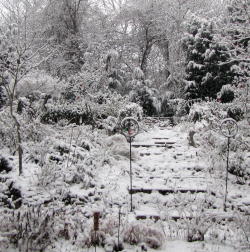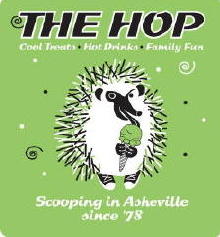
The wildflower fun continues here at the April Fairegarden. Black Jack in the pulpit, Arisaema triphyllum, a passlong from dear Christopher of Outside Clyde, brings joyful memories of visits to a mountain paradise in Western North Carolina. His father, Robert, who had the wisdom to buy the parcel of land long ago recently passed away. Christopher wrote the most eloquent of eulogies that can be seen by clicking here-The House My Father Built. It was an honor to know this fine man, who was also a very fine gardener.

Part of the fun of growing wildflowers that are native to your area is seeing the wildlife they attract. Hummingbirds have been seen feasting on both the near vine of Lonicera sempervirens and the vine on the arbor, Bignonia capreolata ‘Tangerine Beauty’. Alas, no photos. Yet.

Woodland Phlox divaricata comes in shades of blues.

This new purchase is nearly white, P. divaricata ‘May Breeze’. It sits atop the deck wall waiting to be placed to best advantage.

Another close relative to the woodland phlox is PPPP, championed by Gail of Clay And Limestone, the inventor of Wildflower Wednesday, the fourth Wednesday of each month that is set aside to show off the wildings throughout the year. All those Ps stand for practically perfect pink Phlox pilosa. This very plant originated in her lovely garden! Thank you, my dear friend.

Please ignore the white handkerchief looking Clematis ‘Candida’ growing on the shed and focus your attention to the grand Hemlocks, Tsuga canadensis now showing chartreuse tips of new growth. A line of these native trees form a hedge along the back property boundary, doing an exemplary job of hiding the chain link fence and providing privacy.

Diligent searching will reveal the artistry of the baby cones, hiding on the underside of the branches.

This golden leaved cultivar of our native elderberry, Sambucus canadensis ‘Aurea’ is not really all that gold. But it is a favorite of the birds who find both shelter from the hot summer sun and sustenance from the dark blue berries that will cover the branches after these flowers bloom.

Baptisia ‘Carolina Moonlight’ shows another colorway in these native plants besides the white and blue flowered types that are also grown here.

Not all weeds are wildflowers, but some are, like the common fleabane, Erigeron philadephicus. Most of these are pulled out, for there are few plants more prolific in self sowing, but we always allow a few to bloom and set seed. The pollinators love these complex flower heads and the white and pink flowers add to the overall garden appearance.

Emerging fern foliage is one of the most dramatic displays in a spring garden. Cinnamon fern, Osmunda cinnamomea comes forth with astounding beauty and form.
***
Thus ends part two of Wildflower Week, April 2011. Stay tuned for the grand finale. The rest of the story can be found on the link below:
Wildflower Week
Wildflower Week Finale
Frances









That Jack-in-the-Pulpit is a stunner! I also really like the hemlock tree and its cone is spectacular. Looking forward to the grand finale!
Pingback: Wildflower Week « Fairegarden
Frances,
Carolina Moonlight finally this year have impressed me, ours is full just like yours. Been wanting to replace the blue type for years, seems no one carries it, only Carolina Moonlight.
It has been a long time since I have had my woodland garden, but I do enjoy seeing many old friends on your site. My son’s favorite plant was Jack In The Pulpit when he was very young. The Phlox covered that whole south side of my home and the woods beyond. I was a young new gardener at the time and I don’t think I appreciated all of this beauty. I only wanted to be able to grow tomatoes!
Eileen
How can I ingore that clematis? especially, that you’ve tried to push attention away 🙂
what variety is this?
Your photos are so beautiful, and you have such variety. The spring woodland is a wonderful site for wildflowers. I hardly have any woodland near the house, but we are planting a windbreak this spring and I hope we can encourage some wild flowers as well.
The trilliums always amaze me; yours is lovely, Frances, but even more special because of its connection to Christopher and his father. I enjoyed seeing the hemlocks and the elderberry, too; there is always something new to see in your garden!
Frances, your Black jack photo is absolutely wonderful. These plants are so unusual and so pretty and I really like the striping on this particular one.
That is an especially attractive Jack in the pulpit, I must say.
My goodness! I started reading this post, and before I knew it, I had spent over thirty minutes researching baptisias. There are several native to Alabama, and now my wish list has grown longer! Thanks for the inspiration!
Oh how I wish my Arisema would flower instead of producing vast leaves only! As for Baptista I have one but it isnt a very robust plant and has never flowered since I bought it – maybe it needs to find another home
Frances, What a spectacular showing of our marvelous wildflowers~I love jack-in-the-Pulpit! Gorgeous plants~How wonderful to see them blooming and remember such a kind and good gardener. I also appreciate fleabane. (Btw, your photo makes me think of Sid the Sloth from ‘Iceage’. Who is a favorite character). Now, I am going to go back and study your photos a bit more~PPPP does looks splendid with the spirea! I am thrilled, thrilled, thrilled that you love wildflowers! xxoogail PS Thanks for the linklove.
So many lovely natives Frances. Ilove the hemlocks. Those cones are beautiful.
I too have been captivated by the arising fern fronds. They look like something different every day. That Arisaema is quite the treasure.
You have a gift for capturing the beauty of nature. I love the photo of the cone and the ferns emerging. Stunning. I, too, am a big fan of phlox – a charming and long-blooming plant.
I hope you see (and photograph) the hummingbirds soon. I’ve seen them a couple of times this spring, but they don’t yet seem to be regular visitors.
Hope all is OK in your immediate neck of the woods. I,ve just been reading about the recent bout of tornados.
Love Jack. Never saw one with colors like that.
Did you ever make a pie with the Elderberries?
My DIL did. They have 2 trees in their back yard.
Pingback: Wildflower Week Finale « Fairegarden
Frances,
The unknown flower in your camera appears to be celosia, cockscomb. Look forward to reading your blog every week.
Frances, I so enjoyed this. I’m sorry I missed out on Wildflower Week, but I am living vicariously through you and Gail. Cheers!~~Dee